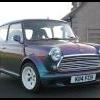yeah miniboo's right, all the gauges will need power, i'm not sure of cable, you wont need anything too heavy duty, go to a car shop and ask for a good length of appropriate wire GET 2 COLOURS red and black, it'll be easier for you to know which is earth and which is positive... thinking about it the wiring may be included in your kit.
Then you want to wire the gauges up to a fuse. Check your fuse box, you may be able to use one of the fuses in there... Haynes manual tells you which ones which. Find a suitable one* attach the positive ( + ) wires and attach the earth wires ( - ) from the gauges to a good earth (clean point of contact on chassis)
By Suitable fuse, you want to find a low amp fuse, thats not being used for too much equipment, and it should only be on when the ignition is on (so your gauges switch on and off with ignition) Best would be to wire in a new fuse for this as you've allot of gauges. Thats all the advice i can give to be honest.

Wiring up digital dials?
Started by
minimanshane
, Dec 26 2005 09:17 PM
34 replies to this topic
#31

Posted 29 December 2005 - 12:20 AM
#32

Posted 29 December 2005 - 01:30 AM
Essentially what you need to create is a new harness for your gauges. I've actually written this reply 3 times now, and it seems that is is very difficult to articulate how to do this. I've built a few harnesses, and it seems simple to me, but obviously people have various levels of knowledge in different areas.
You will need:
1. a good switched positive for the power to the gauges. you can take this off of an existing wire, such as one that comes from the ignition switch (i'll have to look at the haynes manual to advise which one though!). You'll also need to tap into am illumination power source for the backlighting.
2. a good ground. The one from the engine bay front wing seems the most obvious.
3. Plan the position of your various sensors. From there you can see where your wires have to go from, to the gauges.
4. Get a few different colours of wire. This makes it easier to distinguish which wire goes from which sender to which gauge. (or which power source to which gauge)
5. The more time you can spend on it in the first place, the longer it will last. scrimp and save on cheap wires, or forget to insulate things correctly, and you'll end up doing something again in 6 months time. (after a wire gets cut, a connector falls off, or something similar) DON'T rush it just to get it done and looking pretty.
6. Treble check your connections. It actually makes a bit of sense to lay out the sensors and gauges, and to create a mini-harness to ensure you have it right, then to build it in the car with the correct lengths, sizes and colours of wire.
7. WRITE THINGS DOWN. even if it doesn't work, it will narrow things down as to why it doesn't work (plus you can ask here). if you write it down right, then it'll make things easy to follow later. Have a look at a haynes manual diagram for how you should do it. no need for dodgy colour acronyms, or wired symbols, just draw a box for a sender or gauge, and a line for the wire with a colour written next to it!
8. stick an inline fuse in the positive power supply system (and make it easy to get to). This can be good and bad. The bad is that it adds another fuse to check if things go wrong (and is easily forgetable). The good is that if it does go wrong, you wont overload the existing harness and burn out wires.
9.Normally, the gauges will come with a wiring diagram. follow it, even creating individual harnesses, and you can't go wrong.
I hope that helps a bit, and doesn't scare you off. it shouldn't. it really is as simple as joining A to B, but with just a few more colours and volts involved!
Next:
Multimeters. pretty much anything will do. make sure it has cpabilities for at least 20 volts and 50 amps. after that, the number of positions on the dial depends on how you feel about it. Autoranging is easier, but will invariably cost a bit more.
Speedo sender. Surely the speedo comes with a sender. If not then the supplier of your gauges will have access to one that is compatible. There are various ways of sending this signal to the gauge, and they obviously need to be compatible.
You will need:
1. a good switched positive for the power to the gauges. you can take this off of an existing wire, such as one that comes from the ignition switch (i'll have to look at the haynes manual to advise which one though!). You'll also need to tap into am illumination power source for the backlighting.
2. a good ground. The one from the engine bay front wing seems the most obvious.
3. Plan the position of your various sensors. From there you can see where your wires have to go from, to the gauges.
4. Get a few different colours of wire. This makes it easier to distinguish which wire goes from which sender to which gauge. (or which power source to which gauge)
5. The more time you can spend on it in the first place, the longer it will last. scrimp and save on cheap wires, or forget to insulate things correctly, and you'll end up doing something again in 6 months time. (after a wire gets cut, a connector falls off, or something similar) DON'T rush it just to get it done and looking pretty.
6. Treble check your connections. It actually makes a bit of sense to lay out the sensors and gauges, and to create a mini-harness to ensure you have it right, then to build it in the car with the correct lengths, sizes and colours of wire.
7. WRITE THINGS DOWN. even if it doesn't work, it will narrow things down as to why it doesn't work (plus you can ask here). if you write it down right, then it'll make things easy to follow later. Have a look at a haynes manual diagram for how you should do it. no need for dodgy colour acronyms, or wired symbols, just draw a box for a sender or gauge, and a line for the wire with a colour written next to it!
8. stick an inline fuse in the positive power supply system (and make it easy to get to). This can be good and bad. The bad is that it adds another fuse to check if things go wrong (and is easily forgetable). The good is that if it does go wrong, you wont overload the existing harness and burn out wires.
9.Normally, the gauges will come with a wiring diagram. follow it, even creating individual harnesses, and you can't go wrong.
I hope that helps a bit, and doesn't scare you off. it shouldn't. it really is as simple as joining A to B, but with just a few more colours and volts involved!
Next:
Multimeters. pretty much anything will do. make sure it has cpabilities for at least 20 volts and 50 amps. after that, the number of positions on the dial depends on how you feel about it. Autoranging is easier, but will invariably cost a bit more.
Speedo sender. Surely the speedo comes with a sender. If not then the supplier of your gauges will have access to one that is compatible. There are various ways of sending this signal to the gauge, and they obviously need to be compatible.
#33

Posted 29 December 2005 - 01:43 AM
^ I think thats well articulated, however I'm not sure if wiring for illumination is required... these are all digital gauges so unless they are designed to dim when your lights are on i don't think its nessesary.
#34

Posted 30 December 2005 - 05:28 AM
Good point about the illumination. If those are LED displays and not LCDs there may not even be provisions for lighting.
Pikey7, sadly, most of the aftermarket speedometers I've seen don't attempt to provide a sending unit since the number of possible transmissions are endless. If he uses the links at Caerbont I'm sure he'll be able to find one compatible with a Mini. Most British car's I've worked on used that M19x1 thread on the gearbox end of the speedometer cable so there certainly will be some to choose from. I still suspect the cheapest option would be one from a 1990s Jaguar in the scrap yard.
Pikey7, sadly, most of the aftermarket speedometers I've seen don't attempt to provide a sending unit since the number of possible transmissions are endless. If he uses the links at Caerbont I'm sure he'll be able to find one compatible with a Mini. Most British car's I've worked on used that M19x1 thread on the gearbox end of the speedometer cable so there certainly will be some to choose from. I still suspect the cheapest option would be one from a 1990s Jaguar in the scrap yard.
#35

Posted 17 March 2006 - 04:55 PM
any chance of an update on how this is going?
1 user(s) are reading this topic
0 members, 1 guests, 0 anonymous users
















